Recipe and direction on how to make moonshine at home:
It is important to make yourself aware of the laws concerning the distillation of alcohol. Distilling is legal in some countries such as New Zealand. However, it remains illegal in many parts of America and Europe. Many states will allow you to distill alcohol if you are using if for fuel, but you will need to get the required permits.
Moonshine is illegally distilled whiskey, usually clear with a very high alcohol content. It got its name due to the fact that it has historically been distilled at night “by the light of the moon.” Moonshine, white lightning, white dog, hooch, white whiskey, and rot gut are all terms used to describe high-proof un-aged spirits. Moonshine is traditionally made with a combination of processes sugar and corn meal. Moonshine is illegally distilled alcohol. Many liquor stores and distilleries marker their product as being moonshine. However, this is nothing more than a cheap marketing ploy. If you can buy it in as store, than it’s not moonshine. It’s marketing.
Moonshine has historically been a large part of life in rural Appalachia. Backwoods distilling culture was largely introduced to the area by Scottish and Irish immigrants. These immigrants combined their distilling knowhow with locally available crops. Distilling alcohol quickly took over the frontier. Farmers quickly learned that making whiskey was an easy way to use up leftover grain. It was also easier to transport and fetched a higher price. It wasn’t long until white whiskey was flowing from the mountains.
Whiskey was so profitable that even George Washington decided to get into the distilling business. At one point Washington owned arguably the largest distillery in America. It also didn’t take long for the newly formed American government to decide that they wanted a piece of the action. The U.S. government decided that they wanted to start taxing distilled spirits. This new tax gave birth to the first moonshine movement. Farmers and rural settlers started 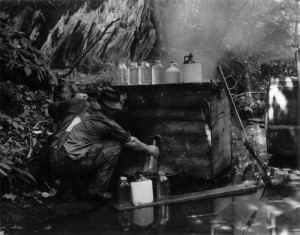 taking their operations deep into the back woods. They also gathered up their guns and started raising hell with the revenue officers. This all culminated into an event that is popularly referred to as “The Whiskey Rebellion.”
taking their operations deep into the back woods. They also gathered up their guns and started raising hell with the revenue officers. This all culminated into an event that is popularly referred to as “The Whiskey Rebellion.”
The most important thing to consider when making moonshine is safety. When making moonshine you should only use copper, stainless steel, food grade plastic and wood. Lead poisoning is a major health risk involved with making moonshine. Most of the stills that are sold online are safe. Especially if you buy them from New Zealand where home distilling is legal. When it comes to fermenting your mash, you will want to be careful to use food grade plastic. You can easily find a food grade fermentation vessel either at your local home brew supply shop or online.
It would be difficult to produce enough methanol to cause blindness or death. Typically the foreshots have the greatest concentration of methanol. The foreshots are the first couple hundred ml to come out of the still. How much foreshots you produce will depend on the size of the still. You will want to throw out the first 200 ml if you are using 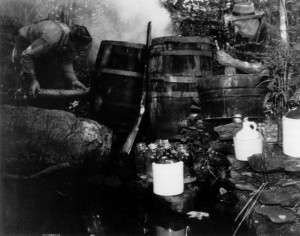 a 5 gallon still.
a 5 gallon still.
Here is a simple moonshine recipe that is perfect for any beginner who is interested in making moonshine. This recipe is for a 5 gallon mash. You can modify the recipe depending on the size of your fermentation vessel. You will need the following for this moonshine recipe:(click here to buy distilling yeast)
6 gallons of water.
10 pounds of corn meal.
7 pounds of Cane Sugar.
2 tsp Gypsum
Distiller’s Yeast, I would recommend Prestige.
Step 1 Preparation: You will first want to weigh out all of your ingredients beforehand. Once you have weighed out your ingredients, you must make sure that all of your supplies have been sanitized, most importantly your fermentation vessel.
Step 2 making moonshine mash: You will want to heat a large kettle of water to 150 degrees Fahrenheit. Once your water reaches 150 degrees you are ready to add your corn meal. You do not want the temperature to go over 165 degrees. The reason for this is that the hot water will help turn starch into sugar. When mashing corn you will want to make sure that you constantly stir it for a good 30-40 minutes. Unlike other grains (such as barley) corn will sink to the bottom where it will clump together and burn. Burning your corn is one of the easiest ways to ruin your batch.
Step 3: After sufficient time has passed, you will want to add your sugar and put your kettle someplace where it can cool. Once it has cooled down to 80 degrees, you are ready to add it to your fermentation vessel.
Step 4: Previous to distilling, the processes of brewing and fermentation are necessary. After you add your ingredients to your fermentation vessel you will want to fill it the rest of the way with water and add your gypsum (gypsum is not required, but recommended). You will want to then stir your mash in order to get it well oxygenated. Remember that the above recipe is enough to make 32 quarts. You will want to edit the amount of ingredients you use depending on how much you intend to ferment.
Step 5 Fermentation: You will want your mash to be around 75 degrees Fahrenheit, although the optimal temperature will depend on the kind of yeast that you are using. I would recommend using prestige distillers yeast. You will want to use more packets of yeast if you are fermenting a higher quantity. The reason for this is that the yeast will have to compete with any bacteria of wild yeast that has found its way into your fermentation vessel. Also, the more yeast you add, the faster it will ferment.
You are ready to add your yeast once the temperature is at or around 75 degrees. Place your vessel of mash in a warm place for several days. The fermentation process can take anywhere from three days to one week. You may find it a advantageous to use a heating pad and blanket to keep your mas warm. You will also want to keep your fermentation vessel covered at all times. You may also find it advantageous to add a couple pounds of sugar after the first two days. This added sugar will help increase the alcohol content. However, if you add too much sugar in the beginning the yeast can become stressed out. Too little sugar and your fermentation may become stalled or fail to begin.
Step 6: You should start to see a foamy head appear within a few hours after adding your yeast. If you don’t see any foam or bubbles after the first day, than you have a problem. This could be caused by several factors. The most common are that you either don’t have enough sugar or the temperature is to hot or too cold. You are ready to start distilling once your mash stops foaming and the yeast has settles to the bottom.
Step 7 Distilling moonshine: The most important thing to know about distilling is safety. First and foremost, you should not drink any alcohol while your still is running. Also, alcohol is highly flammable, so treat it as such. There is a common myth that stills will blow up. This is mostly a myth, but it’s still possible. The biggest cause of this is having a condenser that is too 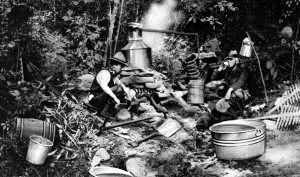 small. If there isn’t any way for the steam to escape, pressure will begin to build up and cause your still to blow out. This is an incredibly rare occurrence that most often happens with poorly made home produced stills.
small. If there isn’t any way for the steam to escape, pressure will begin to build up and cause your still to blow out. This is an incredibly rare occurrence that most often happens with poorly made home produced stills.
Another important thing to note is that distilling can take hours, and you don’t want to leave your still unattended. Distilling can take anywhere from 3 to 9 hours depending on the size of your still. You will need to have few distractions during this time.
After your mash is done fermenting you will be ready to make your first run. If you are using a pot still (the most commonly used) you will need to do two runs. The first run is called the “beer stripping run.” After your first run you will have what is called low wine. Low wine will be around 40-30% alcohol. Check the alcohol content with an alcohol hydrometer until the alcohol content drops below 20%.
You will have to do several beer striping runs until you have enough “low wine” to do your final run. You final run is called the “spirit run.” The spirit run is where you will make your cuts and decide what to keep and what to re-distill with your next batch of low wine.
If you are using a 5 gallon still, you will have to do around 4-5 beer striping runs until you have enough to do your spirit run. Unless you are using a larger still for your beer striping run and a smaller still for your spirit run. However, you can also add the heads and tails from previous spirit run. If you choose to do this (most do) you may find it advantageous to water your low wine down to 40 percent.
When you do your spirit run you will want to make your cuts. Making cuts refers to deciding what you will want to keep what you will want to redistill. Making good cuts is one of the most important aspects of making good quality moonshine.
Step 8 making cuts: Perhaps the most important part of distilling is making the right cuts. Cuts refer to the alcohol you keep and the alcohol you throw out or re-distill. There are three parts to making cuts. These are the Heads, Hearts, and Tails. The Heads are what comes out first. The Hearts are what comes out midway through the run. And the Tails are the last to come out. The Heart of the run is what you will want to keep. You do NOT want to keep the Heads or the Tails.
So how can you tell the difference between the heads, hearts, and tails? For this you will need your sense of taste, smell, and an alcohol hydrometer.
For a 5 gallon still you will want to throw out the first 250 ml that comes out. The first alcohol that comes out is poisonous and bad for your health. You do NOT want to keep of drink it. The next thing you will want to do is to store everything that comes after this into small Mason jars. Keep these jars lined up from the first alcohol to come out of your still down to the last.
After you have all the jars filled and lined up, you will be ready to make your cuts. After doing several runs, you will be able to make your cuts based on smell and test alone. Until then you may find it advantageous to use an alcohol hydrometer. An Alcohol hydrometer tells you the alcohol content of your mason jars.
The Heart of your run (the part you keep) will be between 80-60% alcohol. This can vary depending on many factors. The Head of your run will taste and smell incredibly harsh, but as you get into the tails, the alcohol will begin to feel oily and sell somewhat like wet dog. Be sure to water down the alcohol as you taste it. You may think that your Hearts taste and smell too harsh, but remember that everything smells and tastes harsh when it’s 70% alcohol. Typically people will stop distilling once the alcohol coming from the still drops down to 20% alcohol.
After you have made your cuts, you can save your heads and tails to re-distill with your next spirit run. You can mix them together with your low wine and dilute it down to 40% percent.
Step 9 Bottling and Aging: Once you have collected the hearts of your run, you are ready to bottle your moonshine likker. You will want to dilute your moonshine down to 55-40% alcohol. Your moonshine will begin to mellow out and change over time. The best way to age moonshine is in a small oak barrel. You should be able to find a small oak barrel for as little as $100. You can also age it in Mason jars with toasted oak chips. For more information, check out the article on flavoring and aging.
How to make moonshine
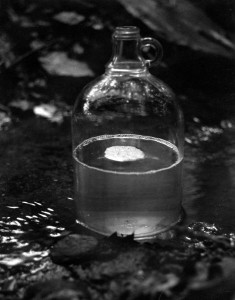
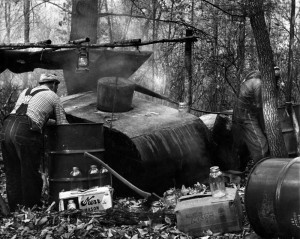
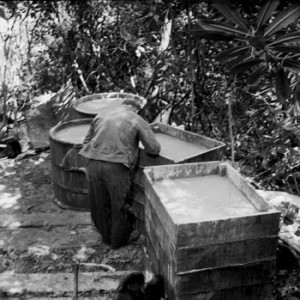
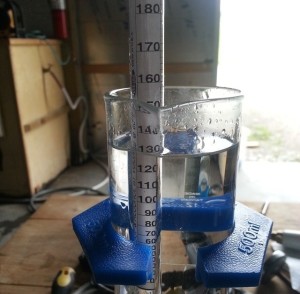
I went over this web site and I conceive you have a lot of good info, saved to my bookmarks (:.
Any suggestions on running an air still? How many times to run it through the stripping run?
I heard that a guy used wild Irish rose wine and distilled some moonshine by just pouring the wine into his pot and running it through. He claimed that it was skipping the first run completely and was ready to drink after only the first run. He also claimed it was around 80% alkyhall. Is there any truth in this at all?
i am most interested in trying out this method ,i happen to like whiskey and just to make a small amount is all i’m after. here have a swig of granny’s moonshine wow !
You don’t say how much yeast?
Just FYI
Most blindness from moonshine results from the use of car radiators for cooling coils.
Good article…wow…do people still use car radiators? I thought that went out in the 1930s!?! OK…I’ve been reading a book called How to Master Moonshine I got on Amazon. It is great…really easy to understand and explains it in detail. I’ll take a stab at answering some questions/comments. First, an air still is quite usable…I’m assuming you mean those little table-top models. Only problem is they can’t process much at a time. Yes, you can quite safely distill wine into alcohol. I doubt he would get 80 percent on the first run though. Also bear in mind that you will get only the alcohol out of the wine, so if it’s 10 percent alcohol, that’s all you’ll get. It would probably be cheaper and easier to make your own moonshine out of sugar. How much yeast you use depends on how big your batch is. One packet of yeast from a wine or brew store is usually enough to ferment 5 or 6 gallons. Stick to wine, beer or turbo yeasts, not bread or bakers yeast. And blindness…if you use food-grade materials (not car radiators), and food safe ingredients (sugar, grain), there is almost no chance you’ll go blind. Methanol is produced in small amounts from grains …any fibrous material can produce methanol, plant matter, grains and obviously wood (wood alcohol is another name for methanol). But, if you wouldn’t eat it, why would you drink it? (I got that from the book!). Hope that helps!
Not sure what that 10 lbs of corn meal is for in the context of this recipe. Cooking your corn meal in water at 150 F (even up to 180 F) is great for releasing the starches contained in the corn, but, in my understanding, just cooking it in water does not convert the starches into sugar, and sugar is what you need for yeast to make alcohol. Personally, I would heat the corn mash to 155 – 180 F, stirring constantly to prevent any burning on the bottom, for an hour or so, until it thickens up good. Then add Alpha Amylase, then hold that temp (appx 155 F) for about an hour while keeping it well stirred. The Alpha Amylase will convert the corn starches into long chain sugars, which ARE NOT FERMENTABLE. You should also notice a considerable thinning out of the mash as the stiff starches are converted to sugars. You then need to reduce the temp of the mash to the proper temp to add Gluco Amylase (usually around 150F – follow the Amylase manufacturers instructions for amounts and temps for both the Alpha, and the Gluco Amylase. Different Amylase’s will work best at different temps). Gluco Amylase will turn the long chain sugar molecules into short chained FERMENTABLE ones which yeast love to eat and turn into alcohol! Now taste it. It should be pretty sweet. Do an iodine test for remaining starch. It’s easy. Now would be the time to add some cool water to start bringing the temp down to about 90 – 100 F and pitch the yeast (proof it first in some warm sugar water). One thing you should do just before pitching the yeast is to pour your mash back and forth a few times between some (clean and sanitized) buckets to get it well aerated. Add sugar (dissolved in warm water), if necessary, after fermentation has begun. Might as well use corn sugar if you can. Adjust specific gravity of the mash to between 1.060 and 1.070 (ten sixty to ten seventy), adding sugar to raise the number, adding water to lower it. Now let it ferment until it’s done. Then, using layers of cheese cloth, strain it out really, really good, and you should have a nice wash for distilling. Make sure you get all the squeezin’s from the meal.
Good luck, hope that helps…
is there a way to test if you have methenal? i ran 3 gallon batch threw out first 100ml but also i did not start producing anything until it hit 185 degrees and it was not a constant drip what does that mean is it still good? if the temp droped it would slow production down. does that mean i produced meythenal?